Ask Ethan: Did our Universe really arise from nothing?

- The origin of the Universe is one of the most pressing existential questions we can face.
- Although science can take us back to the earliest moments of the Big Bang, it can also take us back to before the Big Bang, to a very different epoch.
- Although it sounds like a very “something-y” kind of nothing, cosmic inflation tells us where the entire Universe came from. Here’s the earliest story we know.
The more curious we get about the great cosmic unknowns, the more unanswered questions our investigations of the Universe will reveal. Inquiring about the nature of anything — where it is, where it came from, and how it came to be — will inevitably lead you to the same great mysteries: about the ultimate nature and origin of the Universe and everything in it. Yet, no matter how far back we go, those same lingering questions always seem to remain: at some point, the entities that are our “starting point” didn’t necessarily exist, so how did they come to be? Eventually, you wind up at the ultimate question: how did something arise from nothing? As many recent questioners, including:
- Luke Martin,
- Buzz Morse,
- Russell Blalack,
- John Heiss,
and several others have written:
“Okay, you surely receive this question endlessly, but I shall ask nonetheless: How did something (the universe/big bang) come from nothing?”
This is maybe one of the biggest questions of all, because it’s basically asking not only where did everything come from, but how did all of it arise in the first place, and what existed prior to it? Here’s as far as science has gotten us, at least, so far.
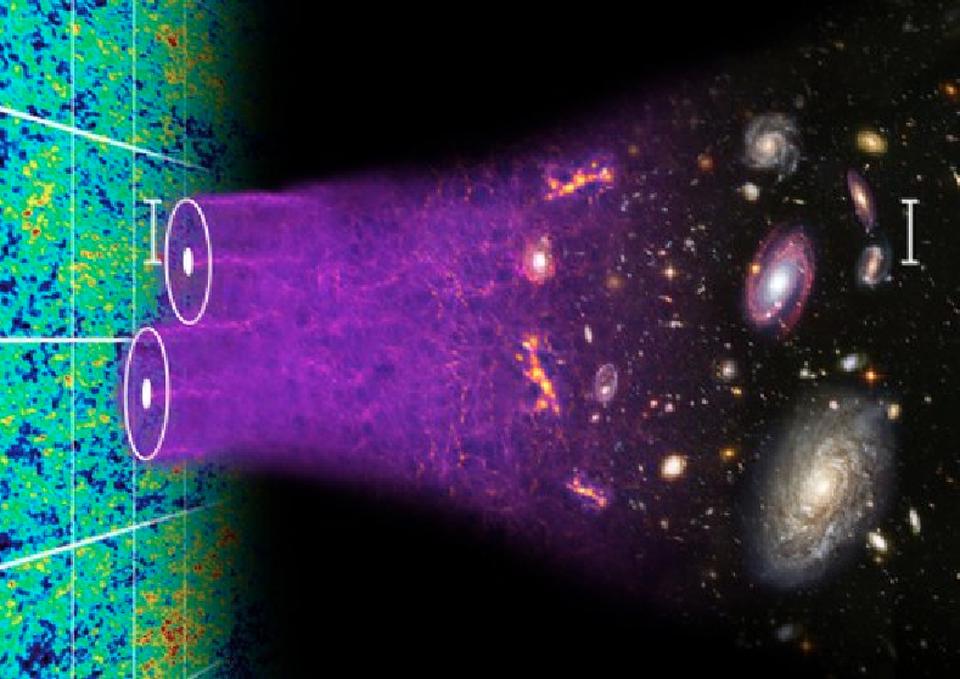
Credit: Chris Blake and Sam Moorfield
Today, when we look out at the Universe, the full suite of observations we’ve collected, even with the known uncertainties taken into account, all point toward a remarkably consistent picture. Our Universe is made of matter (rather than antimatter), obeys the same laws of physics everywhere and at all times, and began — at least, as we know it — with a hot Big Bang some 13.8 billion years ago. It’s governed by general relativity, it’s expanding and cooling and gravitating, and it’s dominated by dark energy (68%) and dark matter (27%), with normal matter, neutrinos, and radiation making up the rest.
Today, of course, it’s full of galaxies, stars, planets, heavy elements, and in at least one location, intelligent and technologically advanced life. These structures weren’t always there, but rather arose as a result of cosmic evolution. In a remarkable scientific leap, 20th century scientists were able to reconstruct the timeline for how our Universe went from a mostly uniform Universe, devoid of complex structure and consisting exclusively of hydrogen and helium, to the structure-rich Universe we observe today.

Credit: Ralf Kaehler and Tom Abel (KIPAC)/Oliver Hahn
If we start from today, we can step backward in time, and ask where any individual structure or component of that structure came from. For each answer we get, we can then ask, “Ok, but where did that come from and how did that arise,” going back until we’re forced to answer, “We don’t know, at least not yet.” Then, at last, we can contemplate what we have, and ask, “How did that arise, and is there a way that it could have arisen from nothing?”
So, let’s get started.
The life we have today comes from complex molecules, which must have arisen from the atoms of the periodic table: the raw ingredients that make up all the normal matter we have in the Universe today. The Universe wasn’t born with these atoms; instead, they required multiple generations of stars living-and-dying, with the products of their nuclear reactions recycled into future generations of stars. Without this, planets and complex chemistry would be an impossibility.
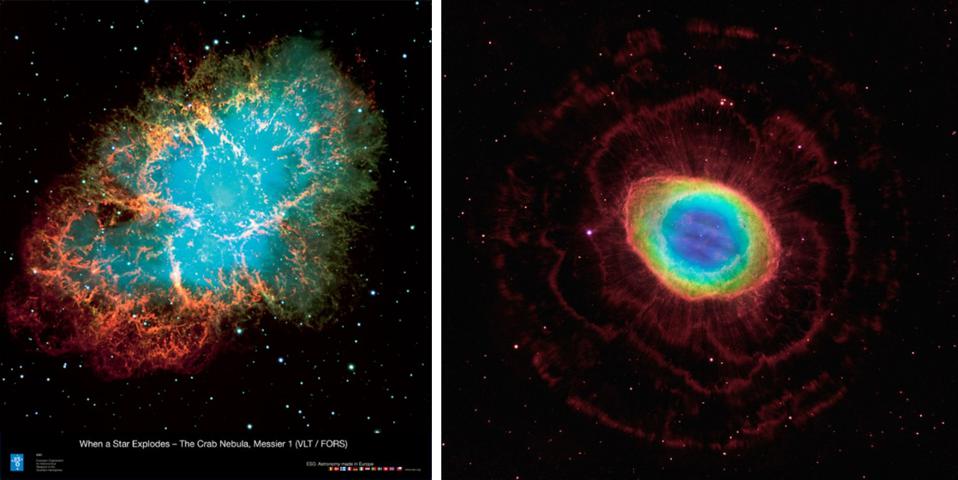
Credits: ESO/VLT/FORS Instrument & Team (L); NASA/ESA/C.R. O’Dell (Vanderbilt) and D. Thompson (LBT) (R)
In order to form modern stars and galaxies, we need:
- gravitation to pull small galaxies and star clusters into one another, creating large galaxies and triggering new waves of star formation,
- which required pre-existing collections of mass, created from gravitational growth,
- which require dark matter haloes to form early on, preventing star forming episodes from ejecting that matter back into the intergalactic medium,
- which require the right balance of normal matter, dark matter, and radiation to give rise to the cosmic microwave background, the light elements formed in the hot Big Bang, and the abundances/patterns we see in them,
- which required initial seed fluctuations — density imperfections — to gravitationally grow into these structures,
- which require some way of creating these imperfections, along with some way of creating dark matter and creating the initial amounts of normal matter.
These are three key ingredients that are required, in the early stages of the hot Big Bang, to give rise to the Universe as we observe it today. Assuming that we also require the laws of physics and spacetime itself to exist — along with matter/energy — we probably want to include those as the necessary ingredients that must somehow arise.
So, in short, when we ask whether we can get a Universe from nothing or not, these are the novel, hitherto unexplained entities that we need to somehow arise.
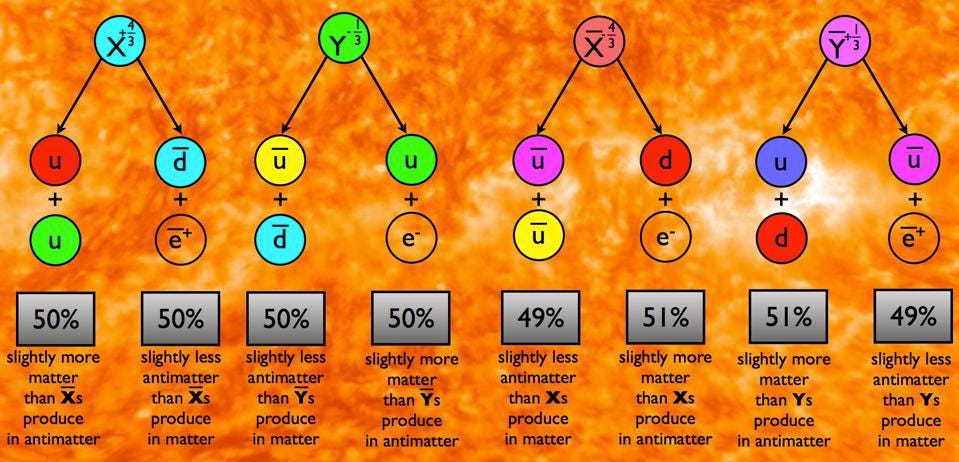
Credit: E. Siegel/Beyond the Galaxy
To get more matter than antimatter, we have to extrapolate back into the very early Universe, to a time when our physics is very much uncertain. The laws of physics as we know them are in some sense symmetric between matter and antimatter: every reaction we’ve ever created or observed can only create-or-destroy matter and antimatter in equal amounts. But the Universe we had, despite beginning in an incredibly hot and dense state where matter and antimatter could both be created in abundant, copious amounts, must have had some way to create a matter/antimatter asymmetry where none existed initially.
There are many ways to accomplish this. Although we don’t know which scenario actually took place in our young Universe, all ways of doing so involve the following three elements:
- an out-of-equilibrium set of conditions, which naturally arise in an expanding, cooling Universe,
- a way to generate baryon-number-violating interactions, which the Standard Model allows through sphaleron interactions (and beyond-the-Standard-Model scenarios allow in additional ways),
- and a way to generate enough C and CP violation to create a matter/antimattery asymmetry in great enough amounts.
The Standard Model has all of these ingredients, but not enough of either steps 2 or 3. If you consider a matter/antimatter symmetric Universe as “a Universe with nothing,” then it’s almost guaranteed that the Universe generated something from nothing, even though we aren’t quite certain exactly how it happened.
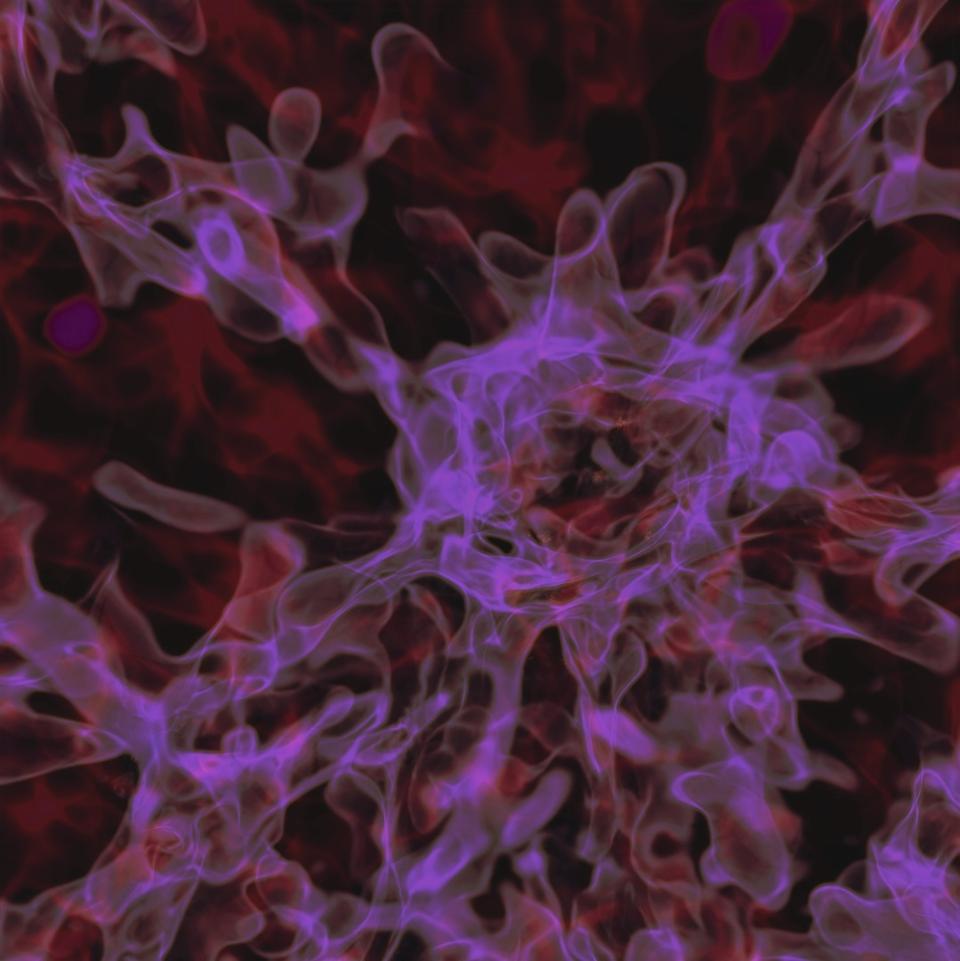
Credit: Aaron Smith/TACC/UT-Austin
Similarly, there are lots of viable ways to generate dark matter. We know — from extensive testing and searching — that whatever dark matter is, it can’t be composed of any particles that are present in the Standard Model. Whatever its true nature is, it requires new physics beyond what’s presently known. But there are many ways it could have been created, including:
- from being thermally created in the hot, early Universe, and then failing to completely annihilate away, remaining stable thereafter (like the lightest supersymmetric or Kaluza-Klein particle),
- or from a phase transition that spontaneously occurred as the Universe expanded and cooled, ripping massive particles out of the quantum vacuum (e.g., the axion),
- as a new form of a neutrino, which itself can either mix with the known neutrinos (i.e., a sterile neutrino), or as a heavy right-handed neutrino that exists in addition to the conventional neutrinos,
- or as a purely gravitational phenomenon that gives rise to an ultramassive particle (e.g., a WIMPzilla).
Why is there dark matter, today, when the remainder of the Universe appears to work just fine early on without it? There must have been some way to generate this “thing” where there wasn’t such a thing beforehand, but all of these scenarios require energy. So, then, where did all that energy come from?
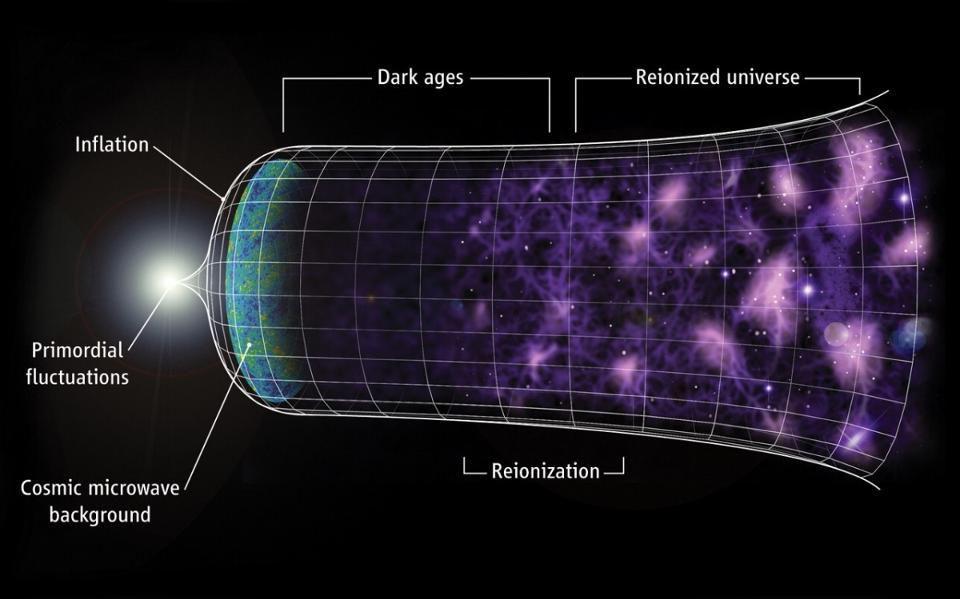
Credit: C.-A. Faucher-Giguere, A. Lidz, and L. Hernquist, Science, 2008
Perhaps, according to cosmic inflation — our leading theory of the Universe’s pre-Big Bang origins — it really did come from nothing. This requires a little bit of an explanation, and is what is most frequently meant by “a Universe from nothing.” (Including, by the way, as it was used in the title of the book of the same name.)
When you imagine the earliest stages of the hot Big Bang, you have to think of something incredibly hot, dense, high-energy, and almost perfectly uniform. When we ask, “how did this arise,” we typically have two options.
- We can go the Lady Gaga route, and just claim it must’ve been “born this way.” The Universe was born with these properties, which we call initial conditions, and there’s no further explanation. As a theoretical physicist, we call this approach “giving up.”
- Or we can do what theoretical physicists do best: try to concoct a theoretical mechanism that could explain the initial conditions, teasing out concrete predictions that differ from the standard, prevailing theory’s predictions and then going out seeking to measure the critical parameters.
Cosmic inflation came about as a result of taking that second approach, and it literally changed our conception of how our Universe came to be.
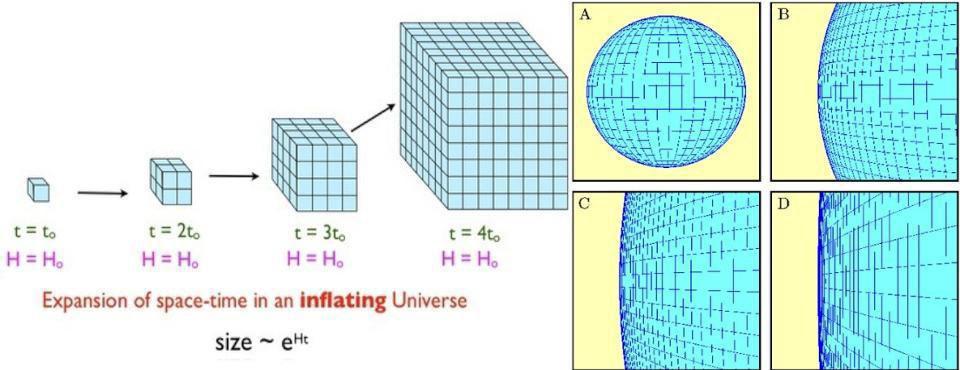
Credit: E. Siegel (L); Ned Wright’s Cosmology Tutorial (R)
Instead of extrapolating “hot and dense” back to an infinitely hot, infinitely dense singularity, inflation basically says, “perhaps the hot Big Bang was preceded by a period where an extremely large energy density was present in the fabric of space itself, causing the Universe to expand at a relentless (inflationary) rate, and then when inflation ended, that energy got transferred into matter-and-antimatter-and-radiation, creating what we see as the hot Big Bang: the aftermath of inflation.”
In gory detail, this not only creates a Universe with the same temperature everywhere, spatial flatness, and no leftover relics from a hypothetical grand unified epoch, but also predicts a particular type and spectrum of seed (density) fluctuation, which we then went out and saw. From just empty space itself — although it is empty space filled with a large amount of field energy — a natural process has created the entire observable Universe, rich in structure, as we see it today.
That’s the big idea of getting a Universe from nothing, but talking about empty space filled with field energy as “nothingness” isn’t going to be satisfying to everyone.
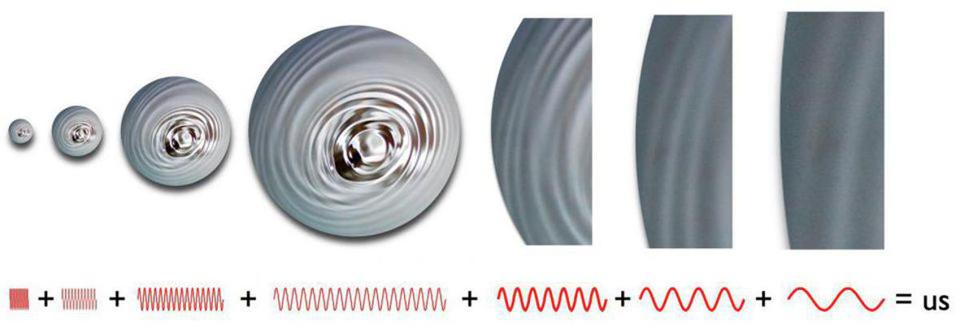
Credit: E. Siegel/Beyond the Galaxy
To a large fraction of people, a Universe where space-and-time still exist, along with the laws of physics, the fundamental constants, and some non-zero field energy inherent to the fabric of space itself, is very much divorced from the idea of nothingness. We can imagine, after all, a location outside of space; a moment beyond the confines of time; a set of conditions that have no physical reality to constrain them. And those imaginings — if we define these physical realities as things we need to eliminate to obtain true nothingness — are certainly valid, at least philosophically.
But that’s the difference between philosophical nothingness and a more physical definition of nothingness. As I wrote back in 2022, there are four scientific definitions of nothing, and they’re all valid, depending on the context in which you use them:
- A time when your “thing” of interest didn’t exist,
- Empty, physical space,
- Empty spacetime in the lowest-energy state possible, and
- Whatever you’re left with when you take away the entire Universe and the laws governing it.
We can definitely say we obtained “a Universe from nothing” if we use the first two definitions; we cannot if we use the third (because the inflationary state was a higher-energy state than the one we have today); and quite unfortunately, we don’t know enough to say what happens if we use the fourth. Without a physical theory to describe what happens outside of the Universe and beyond the realm physical laws, the concept of true nothingness is physically ill-defined, and is purely a philosophical way of approaching the concept of “nothing.”
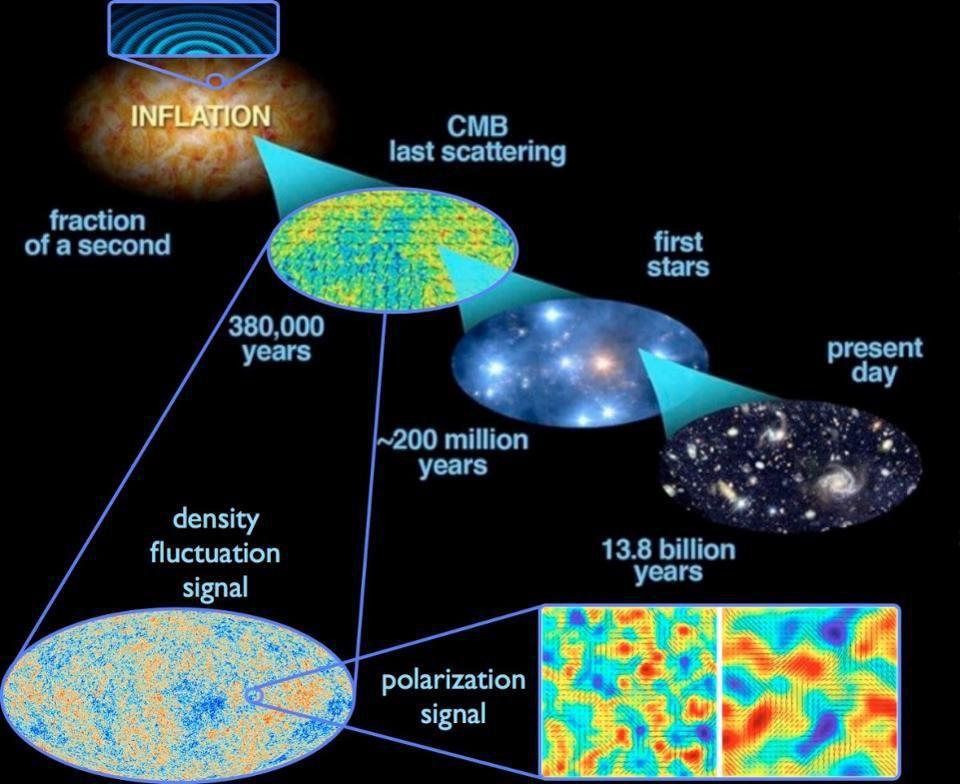
Credit: E. Siegel; ESA/Planck and the DOE/NASA/NSF Interagency Task Force on CMB research
In the context of physics, it’s impossible to make sense of an idea of absolute nothingness. What does it mean to be outside of space and time, and how can space and time sensibly, predictably emerge from a state of non-existence? How can spacetime emerge at a particular location or time, when there’s no definition of location or time without it? Where do the rules governing quanta — the fields and particles both — arise from?
This line of thought even assumes that space, time, and the laws of physics themselves weren’t eternal, when in fact they may be. Any theorems or proofs to the contrary rely on assumptions whose validity is not soundly established under the conditions which we’d seek to apply them. If you accept a physical definition of “nothing,” then yes, the Universe as we know it very much appears to have arisen from nothing. But if you leave physical constraints behind, then all certainty about our ultimate cosmic origins disappears.
Unfortunately for us all, inflation, by its very nature, erases any information that might be imprinted from a pre-existing state on our observable Universe. Despite the limitless nature of our imaginations, we can only draw conclusions about matters for which tests involving our physical reality can be constructed. No matter how logically sound any other consideration may be, including a notion of absolute nothingness, it’s merely a construct of our minds.
This article was first published in March of 2022. It was updated in July of 2025 to run while Ethan is on vacation.
Send in your Ask Ethan questions to startswithabang at gmail dot com!





